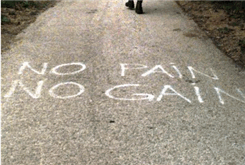 Archive for January, 2012
Archive for January, 2012
Walk Away from Your Day Trades
January 17, 2012 at 10:44 am
Intraday plays can offer exceptional opportunities for not only capturing quick moves, but also for managing risk by avoiding the overnight gap risk. It’s a timeframe which full-time traders often participate in, but one which the part-time trader often avoids due to a perceived inability to manage the trade effectively.
 With today’s trading technologies available to us all, there’s no longer an excuse for missing out on moves when away from your screens. The bracket order is a well-known device for the set-it-and-forget-it type of trade, but there are aspects of it which few utilize.
With today’s trading technologies available to us all, there’s no longer an excuse for missing out on moves when away from your screens. The bracket order is a well-known device for the set-it-and-forget-it type of trade, but there are aspects of it which few utilize.
I’ve realized through helping so many part-time traders who desire to capture some intraday moves that it’s common to simply think inside the box. Most of them view a bracket order as an entry, a stop, and a limit order (set at the target). That’s not at all a bad way to do it, and in fact it’s exactly how I use brackets on my swing trades.
Get Creative
For day trades and the bracket order, a little creativity can go a long way. Mix up the parameters from the usual bracket order you use and throw in a couple of different variables.
One of your stop choices is the trailing stop, which can be excellent for intraday trading. This order allows you to designate either a percentage or a price amount which the stock would have to retreat from its best level (since the trade was entered) in order to trigger a closing order. For the trader seeking to grab as much of an intraday trend as possible, this is a great option to have available – particularly in momentum names which have the ability to keep running.
Another choice which can be made is the time stop for managing exits. This order is based on the clock, so once a given time of day is reached, the next action can be triggered (sell!). Since the whole idea of a day trade is to capture intraday movement and not hold overnight, consider setting a time-triggered order to exit the position ahead of the closing bell.
Here’s what the basic order structure would look like on the thinkorswim platform with a stop buy entry if ABC clears $50, with a trailing stop of $0.50 and a time stop for a market sell late in the day (click to enlarge image):
The trailing stop is set to cancel 10 seconds before the time stop, just for the safety of not having the orders overlap (even though there should be no issue). I clicked the little gear icon beside the order on the far right side of the image above, then selected ‘Cancel order at Specified Moment’ and designated an exact time to cancel the trailing stop (click to enlarge):
The time stop is simply a market sell order which will go live at the designated time, in this case 90 seconds before the closing bell. Again, clicking the gear icon brings up this dialogue box where I simply checked ‘Submit Order at Specified Moment’ and set the time (click image to enlarge):
The bottom-line lesson is this: even as a part-time trader, you can still participate in some intraday moves. Use the technology which is at your disposal, and think outside the box a bit. It can help you manage risk effectively, and if the trade works you can lock in some solid profits – without sitting at your desk!
Trade Like a Bandit!
Jeff White
Producer of The Bandit Broadcast
Follow TheStockBandit on Twitter or get our free newsletter to keep up!
Video Review of the Indexes 1-16-2012
January 16, 2012 at 2:23 pm
Last week provided some early strength, some late weakness, and plenty of lateral price action in between as the indexes finished modestly higher. A long-overdue pullback finally kicked in on Friday, although time will tell whether the dip will prompt more selling or simply provide another opportunity to put cash to work.
The story stocks of the week were generally those which have been quite heavily shorted and/or beaten-down such as NFLX, FSLR (and other solars YGE, TSL, etc.), each of which offered impressive moves higher. Otherwise, we saw some healthy basing action which should help many charts to set up in the days ahead.
In preparation for the holiday-shortened trading week ahead, let’s examine some important levels to keep an eye on for the indexes. That will have the greatest influence on how individual stocks are going to move, so it’s where the trading week’s research begins.
(Direct video link is here for those interested in embedding it elsewhere to share).
Be sure to view in HD (720P) and full-screen mode for best quality in the video.
Trade Like a Bandit!
Jeff White
Come Trade With Us!
Follow TheStockBandit on Twitter or get our free newsletter to keep up!
7 Years!
January 15, 2012 at 1:52 pm
 My, how time flies! Seems like just the other day I was getting started with my trading blog, and here it is now 7 years later.
My, how time flies! Seems like just the other day I was getting started with my trading blog, and here it is now 7 years later.
During this time, I’ve posted about 650 articles and hopefully have helped you and many others along the way. I truly appreciate you reading and commenting, as that feedback always encourages me to share more of what’s useful with you.
Thank you for including me in your routine, your inbox, and for many of you as subscribers to the premium service, for including me in your lives. It’s not something I take lightly!
Going forward, I’ll of course continue to share my insights, trading lessons, charts, and ideas with you here. We have much more to offer via the free email list, so be sure to join that as well if you’re not already on it.
Thank you for making these first 7 years enjoyable, it’s so much easier to share with enthusiasm when readers like you are there to comment with such positive feedback!
Trade Like a Bandit!
Jeff White
Producer of The Bandit Broadcast
Follow TheStockBandit on Twitter or get our free newsletter to keep up!
Week 2 Trades Review (Video)
January 13, 2012 at 4:38 pm
 The first 5-session trading week of 2012 saw a little bit of everything. We saw another big Tuesday gap to the upside, a fair amount of profit-taking on Friday, and a lot of lateral movement in between. Overall, the indexes finished modestly higher, but the net changes on the surface sure didn’t tell the whole story.
The first 5-session trading week of 2012 saw a little bit of everything. We saw another big Tuesday gap to the upside, a fair amount of profit-taking on Friday, and a lot of lateral movement in between. Overall, the indexes finished modestly higher, but the net changes on the surface sure didn’t tell the whole story.
Personally, I took a number of entries as both day trades and swing trades, and it was a really nice week. Both timeframes provided profits, but the day trades did most of the heavy lifting with it being a week where the overall market saw only limited follow through. Then again, that’s exactly why I trade multiple timeframes and share those plays with the membership at TheStockBandit.com.
As I did last week, I wanted to give you a show-and-tell look at the trades I took this week. It should give you a feel for not only how I managed my trades, but also the kinds of setups which have been working well of late. And for those curious about our trading style in the member area, this should give you a good indication of what a typical week looks like. (Note: I do have 2 open swing positions which are not outlined in the video since I’m still discussing my management of them with members).
Be sure to check out the weekend index review video as well.
(Direct video link is here for those interested in embedding it elsewhere to share).
Be sure to view in HD (720P) and full-screen mode for best quality in the video.
Trade Like a Bandit!
Jeff White
Producer of The Bandit Broadcast
Follow TheStockBandit on Twitter or get our free newsletter to keep up!
Setting Stops: Fixed or Variable?
January 12, 2012 at 10:46 am
 Dmitriy recently asked:
Dmitriy recently asked:
“Do you think that fixed stop-loss is better than a stop-loss which is based on market setup (stop below the low of the pullback or below support level)? If for instance, you trade ES or some stock every day, is it best to use a fixed stop-loss, say 3 points in any trade, or one which is based on the unique price pattern and hence requires a different size stop-loss every time (one trade may require 4 points, another 5 points)?”
This is a great question and one I’m glad he asked. Traders of many markets and of differing timeframes wonder about this and come up with mixed signals.
On the one hand, maybe they’ve read O’Neil say in How to Make Money in Stocks to limit one’s loss to 7-8%, which is a fixed amount that doesn’t vary from one trade to another. On the other hand, they realize that no two stocks are exactly alike (or futures or options or whatever instrument is in question). That kind of thinking would necessitate different sized stops depending upon what’s being traded.
 My personal preference is to go with the latter line of thinking. I base my stops on current conditions and the pattern being traded. Some markets are faster than others, so they warrant a smaller position but wider stop. Others are slower and more steady, so they can be traded with larger size but a tighter stop. Personalities of stocks can greatly vary, so it’s difficult to apply a one-size-fits-all stop to every trade you make.
My personal preference is to go with the latter line of thinking. I base my stops on current conditions and the pattern being traded. Some markets are faster than others, so they warrant a smaller position but wider stop. Others are slower and more steady, so they can be traded with larger size but a tighter stop. Personalities of stocks can greatly vary, so it’s difficult to apply a one-size-fits-all stop to every trade you make.
The bottom line is this: those who commit to learning the technicals by studying price action, learning patterns, and personalities of stocks can utilize custom-fit stops and gain a ton of flexibility. By contrast, those who lack that commitment are stuck with using a set percentage which will be more than enough in some cases and not enough in others – very hit and miss.
Grow, learn, and improve – it’s the best investment you could possibly make in your trading.
Trade Like a Bandit!
Jeff White
Producer of The Bandit Broadcast
Follow TheStockBandit on Twitter or get our free newsletter to keep up!
What it Means to ‘Trade Like A Bandit’
January 11, 2012 at 11:02 am
 I cap off every post and free video with the phrase ‘Trade Like A Bandit!‘ Some get that, others don’t. This post is for the latter group!
I cap off every post and free video with the phrase ‘Trade Like A Bandit!‘ Some get that, others don’t. This post is for the latter group!
While teaching in Dallas recently, an attendee casually said to me prior to my presentation, “TheStockBandit…huh…just like Wall Street?” No. I explained that he couldn’t be more wrong to compare my style or what our trader education business is about to the crooked suits who aim to dupe investors Madoff-style into handing over their money.
The guy had no clue what’s in the name TheStockBandit, so I explained to him that day what it meant. In case some of you don’t get it either, I felt it was appropriate to clarify here as well so that there are no misconceptions of what the name is all about.
Here goes…
Think of the great heist movies…Ocean’s 11, The Italian Job, etc. In them, we see that the best bandits plan the hit extensively. They mock up the situation, review scenarios which may unfold, and determine how they’ll handle them.
Then they execute that plan with total precision, even if it means making some adjustments along the way.
In turn, they get away safely and move on to the next job.
That’s exactly how I like to trade.
I want to plan for what might happen in the trade, and do my homework to locate the best setups (targets) in which to allocate capital. Then I need to have the discipline to execute that plan, stay objective throughout, and make any logical adjustments along the way in order to protect myself and my profits as the trade progresses. That allows me to get away (exit the trade) and then shift my attention to the next opportunity.
It’s a blend of survival and protection. I’m ensuring that when a trade goes wrong, I don’t have to surrender any more than is absolutely necessary…I simply abort (stop out). It allows me to survive, to stay flexible, and to maneuver again when an opportunity arises. And when I’m right, I’m capturing those gains and then shifting to the next play.
The word ‘Bandit’ has a negative connotation to some, but that isn’t the case here. I’m not ‘the stock magician’ fooling people with smoke and mirrors, or ‘the stock thief’ pulling the wool over people’s eyes in order to take advantage of anyone. I’m not out to con anyone – I just want to make great trades. Like a Bandit – because it works. Come trade with us and see what I mean.
Trade Like a Bandit!
Jeff White
Producer of The Bandit Broadcast
Follow TheStockBandit on Twitter or get our free newsletter to keep up!
3 Ways to Grow from Trading Adversity
January 10, 2012 at 10:20 am
Dean Karnazes runs like a man possessed. He’s an ultramarathoner, which means he goes beyond marathon distances – sometimes a lot farther. He once ran 50 marathons in 50 states in 50 consecutive days. Apparently, the dude loves pain.
In his book Confessions of an All-Night Runner, he makes the following statement:
“Struggling and suffering are the essence of a life worth living. If you’re not pushing yourself beyond the comfort zone, if you’re not demanding more from yourself – expanding and learning as you go – you’re choosing a numb existence. You’re denying yourself an extraordinary trip.”
So, this being a trading blog, it begs the question: how well do you embrace the struggle of trading? At times it’s really smooth, and trading can provide extraordinary profits in incredibly brief amounts of time, but not always. Sometimes trading’s a real grind. You question everything you’re doing, your results offer you no condolences, and you’re just flat-out suffering.
 If you’ve been through that before and you’re still a trader, congratulations! You have been able to overcome the pain and doubt and press on and work your way out of it. Others of you, however, might be facing that right now for the first time and you’re wondering if you have what it takes.
If you’ve been through that before and you’re still a trader, congratulations! You have been able to overcome the pain and doubt and press on and work your way out of it. Others of you, however, might be facing that right now for the first time and you’re wondering if you have what it takes.
Here’s the thing…if you fall into the latter camp, this is where the rubber meets the road. You’re facing a choice of whether to persevere or to walk away. While moving forward might or might not deliver the success you so badly want, I can guarantee you that permanently walking away will never allow you to reach your trading goals.
Struggle, Suffering, and Success
Struggling and suffering in trading are common side effects of the job, they come with the territory. As you well know, if it were easy then everyone would be doing it. Trading can be hard, it can be demanding, and boy can it be frustrating.
That same struggle can also propel you to new heights of success, but you have to respond the right way – and it’s not gonna be comfortable.
3 Ways to Grow from Trading Adversity:
1. Appreciate the ache. It doesn’t mean you enjoy the frustration. Appreciating it means you acknowledge it’s here, you recognize the fact that a change is needed, and you understand that if you don’t shift in some way it’ll be the end of your trading – at least for a while.
2. Expect to grow. Why shouldn’t you? What you’re doing isn’t working, as otherwise you wouldn’t be facing adversity to begin with. Watch for new kinds of moves, implement some different techniques, and anticipate some different results. If you survive, you’re going to be a better trader because of this time and how you respond to it.
3. Require more from yourself. Maybe you got stagnant, and that’s what brought you to this point of frustration. You’ve had some approaches which have worked, and you rested on them – perhaps a little too much. As traders, we have to continually blend a loyalty to what’s working now with a willingness to employ some new methods. So push yourself more going forward, keep moving, never sit idle when it comes to growing as a trader.
And finally, for some of you this is a wake-up call. You’re starting to become set in your ways, but you now recognize you’re in for a rude surprise if you continue to operate in that manner. No more! Seek out ways to improve, to grow, to add to your skill set. Because according to Dean, getting stuck in your comfort zone means you’re denying yourself something extraordinary – maybe even that elusive next level.
Trade Like a Bandit!
Jeff White
Producer of The Bandit Broadcast
Follow TheStockBandit on Twitter or get our free newsletter to keep up!








